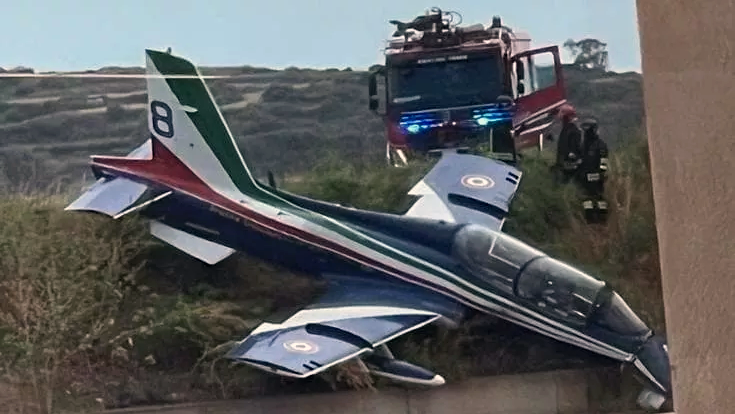The incident occurred during the display over Pantelleria for the airshow. All aircraft landed safely with no injuries on the ground.
Three MB-339 aircraft of the Italian Air Force’s Frecce Tricolori aerobatic display team were involved in a mid-air collision on May 6, 2025, during the Pantelleria Airshow on Pantelleria island, Italy.
According to the videos circulated online, one of the aircraft touched two other jets in the formation. The three pilots managed to land the aircraft: two aircraft suffered serious tail damage, while a third one veered off the runway after the emergency landing. Some unconfirmed reports mention a birdstrike as the cause of the mishap, although this is not clear from the clips.
No serious injuries have been reported even though one of the pilots was transported to the hospital with a suspected leg fracture.
The aircraft involved in the incident are the #6, #8 and #9. Photos shared online show damage to the vertical stabilizer of aircraft #6 and #9, in addition to aircraft #8 being shown off the runway with visible damage to the nose and its underside. According to some unconfirmed reports, the wing of one of the MB-339s might have been damaged, but there is no photographic evidence yet. For sure, the damage to aircraft #8 is significant and it’s not clear, at the moment, whether the aircraft can be fixed. The mishap is probably going to have an impact on the airshow schedule of the team, although no official announcement has been done yet.
A video, recorded from distance (and later pulled from Facebook), shows the aircraft #8 as it lands and veers off the runway shortly after touching down.
Aereo Frecce tricolori va fuori pista a #Pantelleria: ferito il pilota https://t.co/9pEpKg7R4W
— Sky tg24 (@SkyTG24) May 6, 2025
Local emergency services, including firefighters and Carabinieri, responded quickly.
Commercial flights to and from Pantelleria, including DAT services to Palermo and Trapani, were temporarily delayed due to the incident.
Italian Air Force statement
The Italian Air Force has released a statement regarding the incident. Here is the English translation:
On the early afternoon of today, Tuesday, May 6, during an aerobatic training flight of the Frecce Tricolori at Pantelleria Airport, following the Catania airshow, an abnormal separation of the formation during the “cardioid” maneuver required the interruption of the aerobatic program.
Four aircraft from the second section, the so-called “rombetto”, demonstrated mastery of procedures and separated from the rest of the formation. Three of these then landed uneventfully at Pantelleria Airport. The remaining aircraft returned to the military airport of Trapani.
During landing in Pantelleria, one aircraft, due to a technical issue affecting nosewheel controllability, veered off the runway at the end of its ground deceleration run. The pilot was unharmed.
#AeronauticaMilitare: interrotto l’addestramento acrobatico delle #FrecceTricolori a #Pantelleria, velivolo fuori pista dopo l’atterraggio pic.twitter.com/DIEZAvhkAj
— Aeronautica Militare (@ItalianAirForce) May 6, 2025
Frecce Tricolori
The Frecce Tricolori team is heir and guardian of the aerobatic flight’s tradition, which was born in the 1920s at Campoformido airfield, located a few kilometers north-east of Rivolto. Campoformido was the home of the 1° Stormo Caccia (Fighter Wing) and its commander, Lt. Col. Rino Corso Fougier, had the innovative idea in 1928 that aerobatic flight could be used as an essential part of a military pilot’s training to achieve mastery, sensitivity and coordination in any flight attitude, leading to the maximum effectiveness in the military use of the airplane.
The same year, three pilots flew the first demonstration with the Fiat CR.1 biplane fighters flying loopings in formation. The then Royal Italian Air Force was diffident but gave a go to this idea a year later to welcome the pilots who flew for the first from the United States to Rome. The exhibition was a triumph and Campoformido soon became the home of an aerobatic flight school. The school also created in the 1930s one of the most famous maneuvers still flown today by the Frecce Tricolori, the downward bomb burst.
With the years, the “experiment” was extended also to other units, like the 4° Stormo Caccia, and the number of exhibitions increased, together with the number of the aircraft involved in the formation maneuvers. After WW2, the new Italian Air Force resumed these activities in 1952 with the “Cavallino Rampante” (Prancing Horse), which flew with four DH.100 Vampire jets of the 4° Stormo.
The enthusiasm for this return led to the creation of other teams such as the “Getti Tonanti” (Thundering Jets), “Tigri Bianche” (White Tigers), the “Diavoli Rossi” (Red Devils) and the “Lanceri Neri” (Black Lancers).
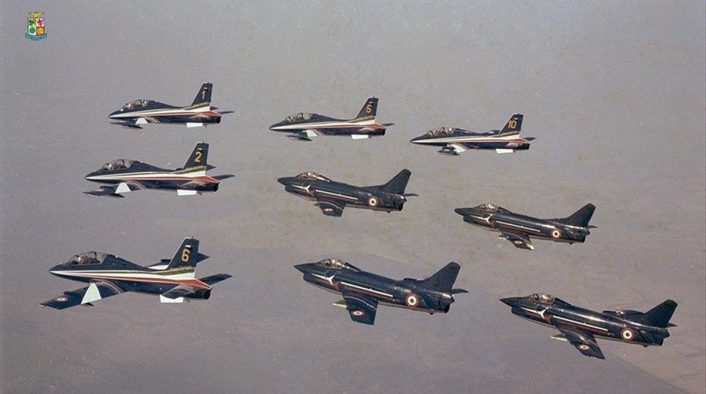
The success of the five teams though the years convinced the Italian Air Force to better manage the aircraft and human resources, creating on March 1, 1961 the 313° Gruppo Addestramento Acrobatico (Aerobatic Training Squadron) at Rivolto Air Base.
The new Pattuglia Acrobatica Nazionale (National Aerobatic Team) performed for the first time on May 1 (thus becoming the traditional day of the first exhibition every year), with six F-86s fitted with smoke generators and painted in a dark blue livery, with a lighter diamond containing a black sword on the sides of the fuselage. A year later, the more famous blue livery with the three green, white and red frecce (arrows) and the yellow tail number was applied for the first time, leading to the name Frecce Tricolori.
In 1963, the now nine-aircraft team received the G.91PAN, a specially modified variant of the Fiat G.91 light fighter aircraft. For the first time since WW2, an Italian aerobatic team was now equipped with Italian-made aircraft, which also allowed a more aggressive display routine and a tighter space required to maneuver. A few years later, in 1966, the solo was added to the formation, with the Frecce becoming the only team in the world to fly with ten aircraft.
In 1982, the MB-339PAN was delivered to Rivolto. Since then, the Frecce begun to fly tours around Europe and the world, winning numerous prizes. Now, after 65 years of history and almost 40 years flying on the MB-339, the Frecce Tricolori are preparing for their next chapter, which will see them flying in a few years on the M-346, reverting the initial decision to equip the team with the M-345.
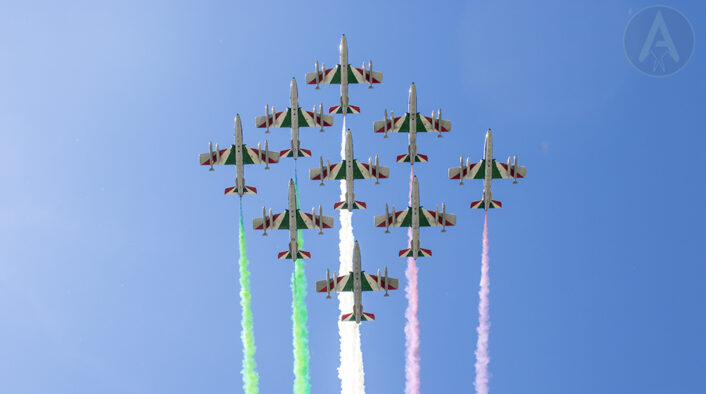
The MB-339 and M-346
The MB-339 was born as a replacement for the MB-326, previously used to train Italian pilots, and designed with almost all Italian technology, with the exception of the Rolls-Royce Turbo Viper 632 engine. The MB-339 flew for the first time in 1976 and was introduced in service in 1981, immediately demonstrating great capabilities both as advanced trainer and as ground attack aircraft.
The MB-339 became even more popular thanks to its adoption by the Frecce Tricolori in 1982. The aircraft also had good commercial success outside of Italy, and has been in service in Argentina, Peru, Malaysia, New Zealand, Nigeria, United Arab Emirates, Eritrea and Ghana. Some MB-339s from New Zealand now found a second life with Draken International, which uses them to support training of allied air forces.
The “Macchino,” as it is also called, has been for a long time a synonym of the 61° Stormo where, in the last 40 years, it graduated 2,500 pilots and flew for 400,000 hours. Even if it’s closing to the end of its service life, the MB-339 continues to demonstrate itself as an exceptional, safe, reliable machine, and is still used in the “analog” A variant for the Phase 2 training and in the “digital” CD variant for the Phase 3.
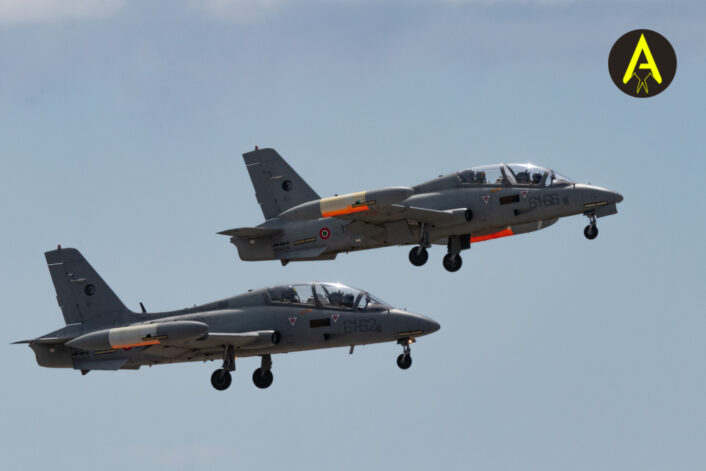
The Frecce Tricolori use a modified version of the MB-339A, called MB-339PAN. The aircraft features key modifications, such as the installation of a smoke system and the removal of the tip tanks, which can be reinstalled for extended-range ferry missions such as the North American Tour 2024.
The latter modification was required as the large tip tanks would limit the maneuverability during certain aerobatic maneuvers. In its standard display configuration, the MB-339PAN is equipped with two “dual use” underwing tanks that hold both fuel and the liquid used for the smoke production.
On Sep. 12, 2024, the Italian Air Force that the M-346 Advanced Jet Trainer (T-346A in accordance with the Italian MOD Mission Design Series) was chosen as the successor of the team’s MB-339s. The new aircraft, adorned with the team’s livery, was officially unveiled at Istrana Air Base in northeastern Italy during a ceremony which celebrated the Frecce Tricolori’s return from their North America Tour 2024. The livery of the new M-346, which was given the number “0”, was designed by Pininfarina, the renowned Italian design and engineering firm famous for its work in the automotive industry, particularly in the design of luxury and high-performance vehicles.
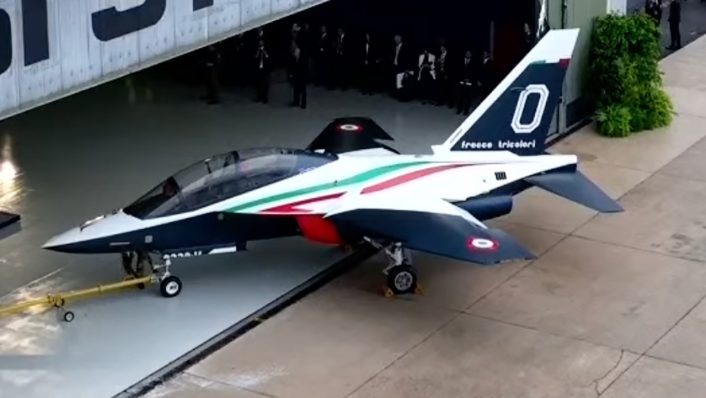
The M-346 was introduced in the Italian Air Force in 2015 and, since then, it prompted a revolution in the training, as it not only brought an aircraft, but an entire integrated system associated with simulators and multiple training aids. The performance of the aircraft, which are very similar to 4th and 5th gen aircraft, make the transition from the trainer to the Operational Conversion Unit extremely smooth, allowing also to offload training activities from the OCU to the Phase IV.
The aircraft’s performance have been further expanded recently, with the increase of the maximum allowed angle of attack from 25° to 30° and the increase of the G limit when the aircraft is equipped with a centerline external fuel tank from 5 G to 6 G. The different performance, compared to the MB-339, will require the Frecce Tricolori to adapt their flight display to the new aircraft.
The Italian Air Force currently operates 18 M-346s, which fly out of Decimomannu Air Base together with four Leonardo-owned aircraft as part of the shared fleet of the 61° Stormo and International Flight Training School. The Frecce Tricolori currently operate 11 aircraft, Pony 0 to Pony 10, plus a number of spares. The service is now acquiring 20 new aircraft, of which 15 will equip the Frecce Tricolori and the remaining 5 will join the 61° Stormo.
The 2023 incident
On Sept. 16, 2023, one of the MB-339A/PAN MLU of the Frecce Tricolori display team crashed on take off from Turin-Caselle airport.
The aircraft was taking off in the first of two 5-ship sections that were due to perform at the Vercelli Airshow 2023 when it experienced a birdstrike that forced the pilot to eject.
Unfortunately, the MB-339 MM54539/4 hit a car travelling on a road just outside the perimeter fence: a 5-year old girl was killed, her mother, father and 9-year old brother were injured.

